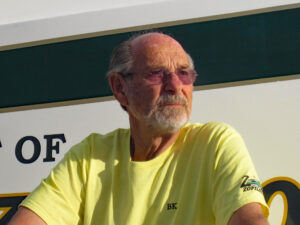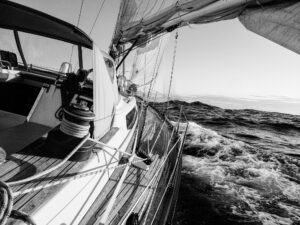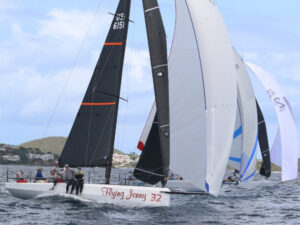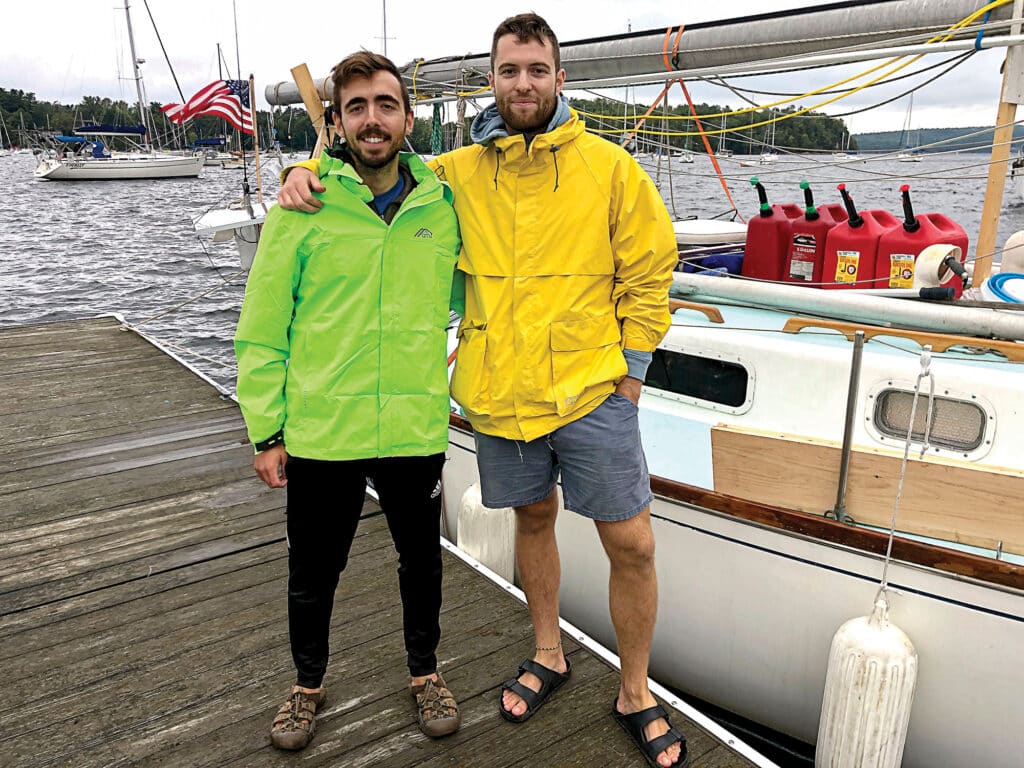
Geese were flying low overhead when I first met the pair on a Malletts Bay dock in Vermont. It was raw, spitting cold rain, and everyone was heading south. The geese were practicing V formations. The two humans were packing more stuff into something that resembled less a sailboat than a shipping container for a dream.
“Send me a picture from the beach at Christmas,” I said to the young men as I waved goodbye.
Three months later, when they did, they were no longer farm boys. They were bluewater sailors.
Finbar Curtin and Rob Root met in high school, went off to colleges in Montana and Virginia, returned as engineers, found good jobs, and, two years later, wondered where they were going.
While their friends held on to security during the pandemic, Root (designing roads for solar arrays) and Curtin (doing analysis for a major bank) daydreamed of adventure together. Kayaks? Hiking? Biking? What about a boat?
For $2,500, they found an O’Day 20, a swing-keel pocket cruiser. They watched online videos and taught themselves to sail. Pretty much every day, sometimes overnight, sometimes in storms, they had a blast. For these engineers, a sailboat was an “autonomous system” that provided shelter, power and a place to sleep while going places that would be hard to get to otherwise.
Four months later, they found a 1969 Tartan 34 C named Sofia. They paid $20,000 and, despite a reassuring survey, found that one thing led to another. While hooking up a windlass, they were shocked by the boat’s wiring, which they replaced. The hoses were connected to original through-hulls. A coat of antifouling uncovered scary fiberglass issues.
While their friends held on to security during the pandemic, Root and Curtin daydreamed of adventure together—what about a boat?
Working in a boatyard through the Vermont winter, they kept regret at bay by picturing themselves, cocktails in hand, on a Caribbean beach. To taste the ocean, they signed on with an experienced captain to deliver a Leopard 50 catamaran from Fort Lauderdale, Florida, to Panama. Back home, nearing launch, they bought a life raft, a refrigerator, lightning and battery protection, a spearfishing gun, a drogue and, they say, because “we both have moms,” a Garmin inReach satellite communications device. Curtin wrote software to translate SSB weather data to their laptops.
A year and another $15,000 later, they had a sailboat they knew inside and out. What remained was a cruising kitty that would allow each man $1,000 a month. With entrepreneurial optimism, they packed away Vermont cheese and 200 pounds of maple sugar produced from their families’ stands. They hoped to sell it in the tropics. They also found room for Root’s grandfather’s sextant, a chessboard, e-readers loaded with books, and, in keeping with Curtin’s Irish roots, a flute, a whistle and a concertina.
As they set off through dense fog in September 2022, with a goal of Christmas on a tropical island, I followed along on their blog. Through their eyes, I enjoyed reliving my own—really, every sailor’s—lost virginity. It comes only once, and Sofia’s crew conveyed an honest, sweet innocence.
“I pretended we were 17th-century voyagers, exploring this inland waterway for the first time,” Curtin wrote in the first post.
After raising their mast on the Hudson River, they caught an ebb tide and ran aground. As New York City’s skyline rose ahead, they anchored and braved the city for pizza. To shelter from Hurricane Ian, they rounded Manhattan, entered the East River, and passed under the Brooklyn Bridge on an 11-knot tidal wave.
A long wait for a weather window in Norfolk, Virginia, as Hurricane Nicole passed by left them nervous as they faced the Gulf Stream and 1,600 miles in the Atlantic. Then came two weeks of radio silence, finally broken in late November.
“Made it!”
Their first blog entry led with Curtin describing that first night at sea, leaning over the rail: “I couldn’t see the churning ocean through my teary squint, but my stomach felt each violent lurch, pitch and roll. I shuddered, partly from the cold, partly from the puking, and tried to collect myself. Weakly pushing myself upright, I gazed into the nighttime abyss and wondered, What have I gotten myself into?”
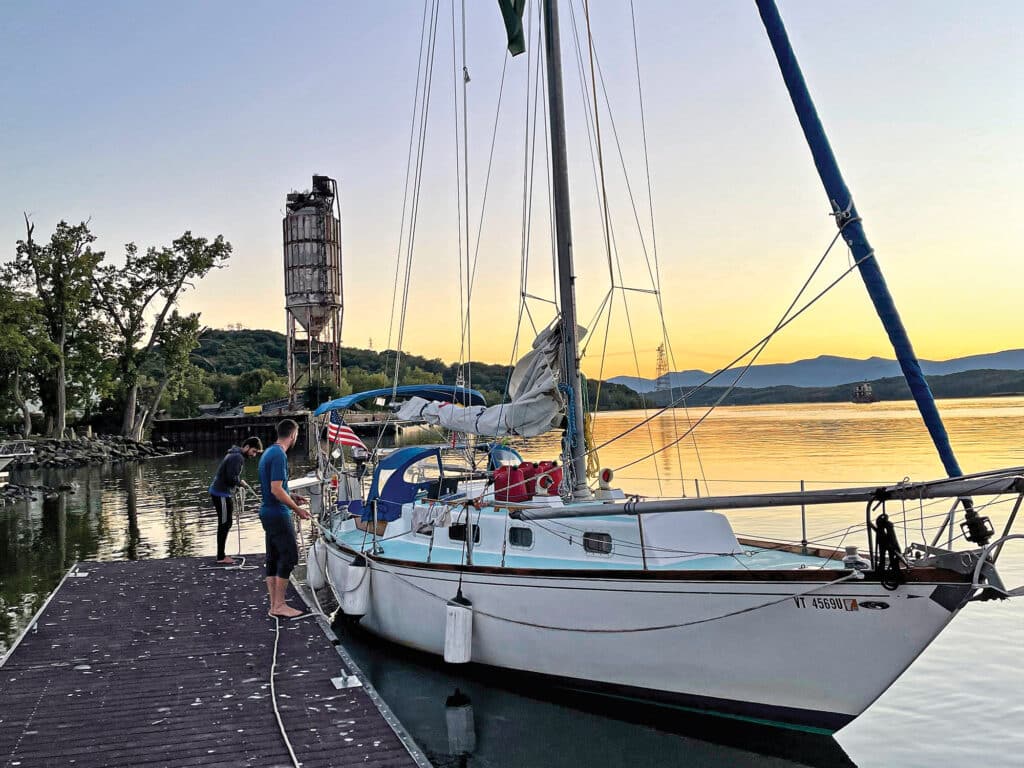
There were great moments: the dawns, the dolphins, the stars, the fish they caught and ate. Then the routine returned, and Root wrote: “After two nights of restless sleep, the days and nights felt like they were melting into one blurry and slightly anxious dream. The constant underlying fear of something breaking, or going disastrously wrong while hundreds of miles offshore, kept eating away at the pure excitement of taking our boat to the Caribbean.”
Finally, the trade winds, and the sight of Saint-Martin. They anchored and dinghied to “the nearest beach bar, and in nearly unintelligible French, ordered a grand meal of beer, chicken, French fries and ice cream.”
On New Year’s Eve, I reached them via video call. They were on a national park mooring off St. John in the US Virgin Islands. The sun was shining, and they were reflective.
Like all cruisers, they had used their boat to go somewhere, starting from knowing nothing about sailing just two or three years earlier. Theirs was also an inward journey: “The only thing out there is your boat and your mind and the things that you can really think about, like what you value within yourself,” Curtin said. “I want to live more—a virtuous life in a way, instead of trying to chase the corporate hustle.”
Root added: “I feel more strongly that I really want to do things that make me happy and not get sucked into doing things that make other people happy. Working on boats would be really fun.”
Sure, there were cruising lessons learned, like a better meal plan to stave off being hungry and grumpy and seasick. Come spring, they might head to Maine, but they don’t foresee any more ocean passages. They had set out to test the boat and themselves. As such, the voyage was a success. They both agreed that they feel like they are the same people, just more confident.
What I saw in these 24-year-old men was a wisdom often mouthed but not always heard: Don’t wait until old age. You don’t necessarily have to cross an ocean to live a life as wide and deep as one.
Based in Vermont, Jim Carrier volunteers as a captain for Sail Beyond Cancer, a nonprofit providing respite sails for cancer patients on Lake Champlain. A CW contributing editor since 2009, he is the author of The Ship and The Storm: Hurricane Mitch and the loss of the Fantome.

